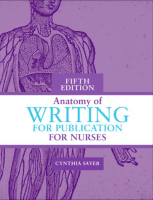You’ve done your homework-years of it, as shown by your doctor of nursing practice (DNP) capstone project. You breathe a sigh of relief, but then quickly wonder if you should submit your work for publication.
The answer is “yes and no.” Publishing can help you reap a return on your educational investment by positioning yourself as an expert in your topic. But you can’t simply attach your capstone project as an e-mail to an editor. That’s a quick route to rejection. Instead, use the tips in this article to boost your chance of success in turning your manuscript into a published article.
Let the transformation begin
Professors are wise to advise students to get their work published. A published article disseminates your work, adding to the body of nursing knowledge and creating the potential to change practice. But regardless of your high-quality work or excellent writing, you must transform your original manuscript to meet the mission, aims, and style of your targeted journal. This takes time but is doable. Don’t wait too long after completing your capstone project to publish. It’s best to take action while the information is still fresh in your mind.
Before you begin your new assignment of creating a publishable article, you need to find the appropriate journal, read the guidelines, and use them to transform your work.
Select a journal
To choose the right journal, ask yourself: What? Who? Where? The answers will help guide you to the appropriate journal and begin to focus your article.
- What are the most important points in your capstone project that must be included your article? Typically, these are highlighted in your abstract.
- Who are the readers who would benefit from the key information in your capstone? Are you targeting nurse practitioners, specialty nurses, multidisciplinary professionals, or someone else?
- Where will you find this group of readers? Do you need to publish in a nursing, medical, or social science journal? Or would a specialty journal connected to a professional organization be most appropriate?
Use these answers to create a purpose statement. Here’s an example: I want to tell NPs working in palliative care [who] about an educational program [what] I developed to increase their XXXXX skills. My targeted journal is name of journal [where].
To find potential journals, turn to the reference list for your capstone project. Use key words from your abstract to search Google or Google Scholar (http://scholar.google.com/) to see which nursing journals have published articles on your topic. Read the mission statement for that journal to see if the journal’s purpose fits with what you want to accomplish.
Be sure to read several different issues of that journal to get a more complete perspective on the types of articles it publishes. Editors consistently complain they receive manuscripts that are nothing like what their journals publish. For instance, American Nurse Today prefers succinct, practice-oriented articles, so your 5,000-word manuscript that includes a lengthy literature review wouldn’t be a good fit.
Query the editor
A query is a short e-mail (or snail-mail letter) to the editor to ask if he or she would consider your topic for publication. A positive reply encourages you that your article might be considered once you submit it and gives the editor a chance to make suggestions for the direction of your topic or a similar one. A negative reply means you won’t waste time writing an article that will be rejected, but instead can find another journal to approach. Some nursing journals state in the author guidelines that queries aren’t accepted, but most editors will readily accept an e-mail.
A query consists of an enticing lead sentence that compels editors to continue reading, plus statements that describe the significance of your topic, why their readers need to know the information, and what qualifies you to write the article. Put a short summary of the query in the subject line of your e-mail; for example, American Journal of Nephrology Nursing: Query for article on innovative patient-education tool for dialysis patients.
Unless the journal specifically states in its author guidelines or on its website that it accepts capstone projects, don’t focus on the fact that your proposed article is based on a capstone manuscript. Mention it as a supporting factor as to why you should be the one to write the article, but avoid implying you’re simply repurposing your project. You want the editor to feel he or she will be receiving a new article and not warmed-over information. Also, avoid such statements as “My instructor said I should publish this article if I got an A on my paper”, or “I plan to use the published article to fulfill part of my DNP requirement.” The work as discussed in your query needs to stand on its own. (See Sample query letter by clicking the PDF icon above.)
Know that an editor’s acceptance of your query doesn’t guarantee acceptance for publication. Your manuscript will need to undergo peer review.
Prepare to write the article
The most important step to take before writing is to read and study the author guidelines. Again, although this seems obvious, editors commonly state that authors fail to do so. Author guidelines contain a wealth of information, such as types of articles the journal publishes, target readership, how many words your manuscript should contain, what reference style you should use, and how to prepare the manuscript for submission.
Once you’ve read some published articles in your targeted journal, consider which ones are similar to the type of article that will best disseminate your capstone‚Äôs key points, such as research article, case study, narrative review, or reflection piece. For instance, if you’re going to write about a quality-improvement project, examine articles related to quality improvement to get a sense of their structure.
Reading the author guidelines and past articles also will give you a good sense of the journal’s editorial tone. Consider whether the tone is conversational, like that of American Nurse Today, or more formal and research oriented, such as the Journal of Nursing Scholarship.
Start writing
Be aware that you’ll need to shorten your manuscript so it fits the length requested in the author guidelines. Begin by keeping the essential points while deleting the nonessential. To help differentiate the two, ask yourself what the reader needs to know as opposed to what is nice to know. You may find it helpful to create a new outline for your article.
Be sure to tailor your article to the journal you’ve chosen. If you’re writing about how to assess pain in cognitively impaired older adults for a practice-focused journal, you’ll want to focus on the step-by-step process of assessing pain in clinical practice. On the other hand, if the journal is more academic, you might want to write a review of current pain-assessment tools for older adults and provide a discussion that includes recommendations for practice.
To keep yourself on track, make short, daily writing appointments with yourself. Don’t expect to write the entire document in one sitting. After your first draft, ask a colleague or faculty member with publishing experience to read it and give you feedback. It’s also helpful to ask someone who reads or is familiar with the journal you are targeting to review your draft. (For additional advice, see Writing tips by clicking the PDF icon above.)
Submit and revise the article
Follow the submission process described in the author guidelines. This may be as simple as e-mailing your manuscript to the editor, or you may need to upload the file to a database the journal has set up for this purpose. Be open to revising the article based on feedback from the editor and peer reviewers. Typically, you’ll receive your article back with suggestions for revision. If your article is rejected again after you‚Äôve revised and resubmitted it, consider retooling it for another journal. If your article is rejected by two different journals, it’s probably time to move on to a new topic or seek help in honing your writing skills.
Achieving success
Although the challenge of turning your capstone project into a published manuscript might be daunting at first, you can do it. With a bit of persistence, you can move from
capstone project to published article—and join the ranks of published authors.
Click here for a complete list of references.
Lorraine Steefel is an adjunct assistant professor in the DNP program at the School of Nursing of the University of Medicine and Dentistry of New Jersey (UMDJN) in Newark. Cynthia Saver is president of CLS Development, Inc. in Columbia, Maryland, and editor of the book Anatomy of Writing for Publication for Nurses.


















